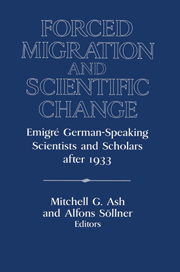Book contents
- Frontmatter
- Introduction: Forced Migration and Scientific Change after 1933
- PART ONE PHYSICAL AND MEDICAL SCIENCES
- 1 Identification of Emigration-Induced Scientific Change
- 2 Physics, Life, and Contingency: Born, Schrödinger, and Weyl in Exile
- 3 Emigration from Country and Discipline: The Journey of a German Physicist into American Photosynthesis Research
- 4 The Impact of German Medical Scientists on British Medicine: A Case Study of Oxford, 1933-45
- PART TWO PSYCHOLOGY, PSYCHONALYSIS, PEDAGOGY
- PART THREE SOCIAL SCIENCES
- Epilogue: The Refugee Scholar in America: The Case of Paul Tillich
- Index
1 - Identification of Emigration-Induced Scientific Change
Published online by Cambridge University Press: 05 January 2013
- Frontmatter
- Introduction: Forced Migration and Scientific Change after 1933
- PART ONE PHYSICAL AND MEDICAL SCIENCES
- 1 Identification of Emigration-Induced Scientific Change
- 2 Physics, Life, and Contingency: Born, Schrödinger, and Weyl in Exile
- 3 Emigration from Country and Discipline: The Journey of a German Physicist into American Photosynthesis Research
- 4 The Impact of German Medical Scientists on British Medicine: A Case Study of Oxford, 1933-45
- PART TWO PSYCHOLOGY, PSYCHONALYSIS, PEDAGOGY
- PART THREE SOCIAL SCIENCES
- Epilogue: The Refugee Scholar in America: The Case of Paul Tillich
- Index
Summary
Many emigration specialists maintain that the loss of approximately 2,000 scientists by Germany between 1933 and 1945 completely shattered that country's basis for scientific research. A reduction of a country's scientific brainpower by more than 30 percent, it is argued, could not fail to produce a disastrous effect on the content as well as the quality of research pursued within that country's scientific institutions. A plethora of purported facts, scholarly expositions, and historical documents appear to prove this point beyond reasonable doubt. A comprehensive synopsis of the historical process in question is, however, unavailable. Moreover, any consolidated evaluation of its global effects on the growth, content, and international standing of the sciences in the countries of emigration and immigration will have to await further research.
The present situation in the field of emigration studies is perhaps best characterized by the following features:
An abundance of either loosely connected or unrelated facts concerning Nobelists and other celebrated scientists profiting from the nonrandom survival of rich archival resources related to their work.
Select records and analyses of some salient institutions, and of a few probably atypical specialties, again depending on the vicissitudes of available archival data.
Very occasional information about the development of personal networks, or schools of research, involving emigrants.
Virtually nothing, except for “thin descriptions,” of a testable kind concerning more universal categories of science such as disciplines, fields or specialties.
All together, such features yield a picture of too many open questions, too many extrapolations or other unfounded speculations derived from cases whose typicality is uncertain, too many isolated facts that constitute pieces of the puzzle but leave the larger picture blurry and indiscernible.
- Type
- Chapter
- Information
- Forced Migration and Scientific ChangeEmigré German-Speaking Scientists and Scholars after 1933, pp. 23 - 47Publisher: Cambridge University PressPrint publication year: 1996
- 7
- Cited by

